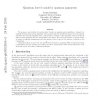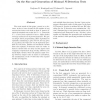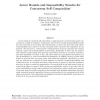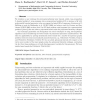106 search results - page 3 / 22 » Proving Lower Bounds Via Pseudo-random Generators |
STOC
2000
ACM
13 years 11 months ago
2000
ACM
We propose a new method for proving lower bounds on quantum query algorithms. Instead of a classical adversary that runs the algorithm with one input and then modifies the input,...
VLSID
2006
IEEE
14 years 1 months ago
2006
IEEE
The main result of this paper, proved as a theorem, is that a lower bound on the number of test vectors that detect each fault at least N times is N
JOC
2008
13 years 7 months ago
2008
In the setting of concurrent self composition, a single protocol is executed many times concurrently by a single set of parties. In this paper, we prove lower bounds and impossibi...
IPL
2011
12 years 11 months ago
2011
Ellul, Krawetz, Shallit and Wang prove an exponential lower bound on the size of any context-free grammar generating the language of all permutations over some alphabet. We genera...
CORR
2010
Springer
13 years 4 months ago
2010
Springer
We introduce a new technique for proving kernelization lower bounds, called cross-composition. A classical problem L cross-composes into a parameterized problem Q if an instance o...




